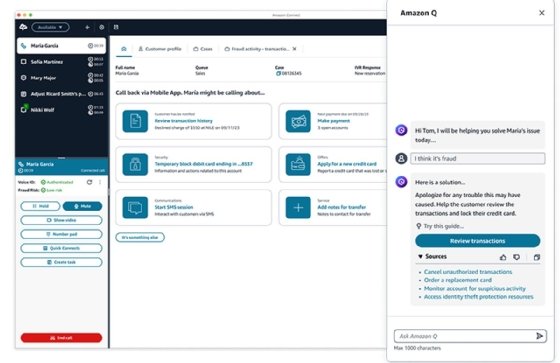
Getty Images/iStockphoto
AWS' Amazon Q in Connect adds more contact center GenAI
AWS updates its contact center-specific version of its generative AI-powered agent, Amazon Q, for the company's Connect Contact Center as a Service platform.
After a year on the market, AWS beefed up its contact center-as-a-service generative AI agent for Amazon Connect with personalized recommendations, company-specific language and legal verbiage.
The customer service agent assist tool, Amazon Q in Connect, was formerly known as Amazon Connect Wisdom. AWS also has other variants of its Q generative AI assistant, including Amazon Q Business for workflow automation and knowledge aggregation; Q Developer; Q in AWS Supply Chain, released this week; and Q in QuickSight for business intelligence.
AWS built the no-code contact center agent on the Amazon Bedrock machine learning platform, which connects to large language models (LLMs) from sources including Anthropic, Cohere and AWS' own.
It gives IT admins and contact center leaders a set of bidirectional administrative and security guardrails to make sure that internal data and customer data, which are key to adopting generative AI in the contact center, don't cross into places they shouldn't, said Liz Miller, an analyst at Constellation Research.
"[AWS] created specialized connectors and out-of-the-box prompting for Q in Connect, which is very specific around what [data] will be most helpful for contact center agents to access across the business," Miller said. "It is actually thoughtful around people's objections to adopting generative AI: 'If I turn on generative AI across my business, will it actually give the wrong people permissions into the wrong things?'"
Generative AI has recently heated up the contact center-as-a-service market, as Google released a full CCaaS to host its LLM-based services. Zendesk, Oracle and Salesforce also released autonomous agents powered by GenAI.
Customers will need to plug Q in Connect into their knowledge bases and various other AWS tools to activate real-time personalized recommendations to agents. One is Amazon Connect Flows, which in turn accesses Amazon Lex intent and conversation transcripts. Other integrations required include Amazon Connect Customer Profiles and Connect Cases, which load customer preferences, purchase history and loyalty program data when applicable.

Q in Connect users can also customize the agent to use language and terms commonly used in industries such as financial services. It also can follow user-set rules for agents, such as addressing customers by first name. Further, branding language, such as references to a company's core values, can be baked into Q in Connect's suggested responses, as well as prompts with mandatory legal language, such as disclaimers and terms and conditions.
Many of the features in Q in Connect as well as Amazon Connect overall are driven by customer requests, said Michael Wallace, AWS Americas solutions architecture leader for CX.
"Feedback from many customers formed our growth around Q in Connect," Wallace said. "Feature growth informs other features, so things like personalization and customization within Q in Connect help us get better at using generative AI to help agents -- and help their customers get their responses quicker."
Availability of Amazon Q in Connect differs by region. AWS deliberately rolls out features one region at a time to limit issues geographically if and when they crop up, Wallace said.
Don Fluckinger is a senior news writer for TechTarget Editorial. He covers customer experience, digital experience management and end-user computing. Got a tip? Email him.








